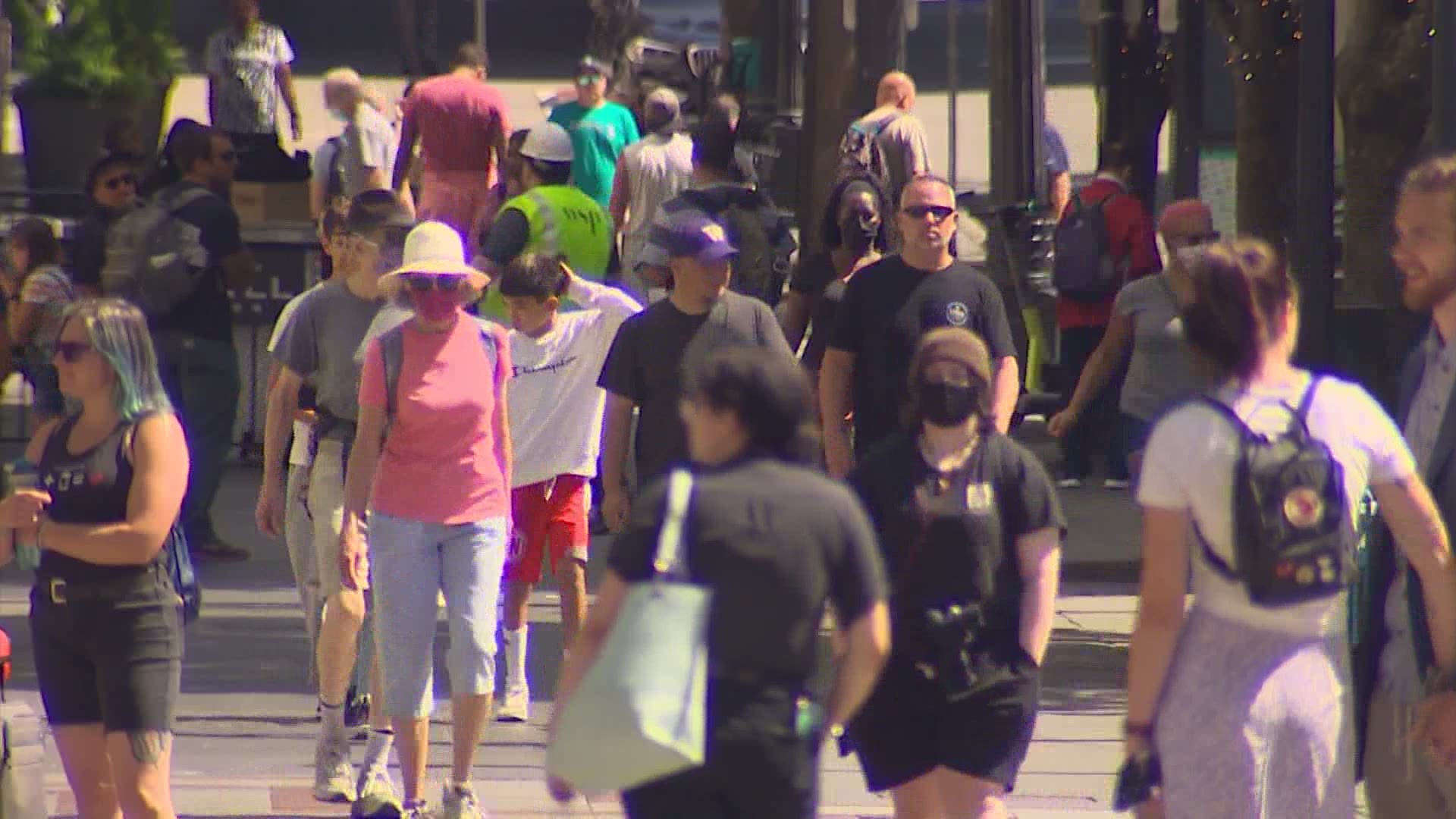SEATTLE — More than half the counties in Washington should return to masking indoors regardless of vaccination status, according to new guidance released by federal officials Tuesday, citing concerns over surging coronavirus cases driven by the more infectious delta variant.
Communities with “high” and “substantial” case rates are impacted by the guidance, which includes 63% of U.S. counties. Substantial means 50-100 cases per 100,000 people on a 7 day average, and high is 100+ cases. You can view the map here.
While King County squeaks in just over that mark at 53 cases on average, or the low end of substantial, Snohomish County rates high at 120 cases, and Spokane County much higher at almost 260.
This departs from previous guidance from the Centers for Disease Control and Prevention (CDC) that vaccinated people could resume much of their normal activities without masks, and comes weeks after Washington fully reopened, dropping most pandemic restrictions.
“If there’s one thing that I’ve learned about being in the healthcare system in a pandemic, it’s that you need to make the best decisions available with the data and information that you have at the time,” said Dr. Amanda Kost, a family physician with Harborview Medical Center in Seattle. “We’re in a different time right now.”
Masks have been and remain a state requirement in public for people who are not fully vaccinated.
The CDC announcement is a sharp about face after only a few weeks of mask-free life. Last week, Public Health -- Seattle & King County's Health Officer Dr. Jeffrey Duchin recommended a return to universal indoor masking, citing increased variant spread. On Monday, seven additional counties across Puget Sound signed on to that recommendation, including Pierce and Snohomish counties.
Certainly a return to masks comes with some feeling of frustration, as millions of Americans have received the vaccines while watching a swatch of the population refuse or delay the shot. But Kost said it’s important not to oversimplify that narrative: there are still issues of access because of social inequity, such as historic distrust of the medical system in BIPOC communities, and lack of employee access to sick time for the shot and recovery.
Compounding that, children under 12 are still not eligible for the COVID-19 vaccines, and several million Americans with compromised immune systems are still at increased risk, even after vaccination.
Which is the quagmire the country finds itself, as the masks return, and vaccination rates stall.
“People are tired and it's not done,” Kost said. “And you can hold both of those things in your head at the same time.”
Certainly, many never gave up their masks in some settings by choice. But masks have also been made a politically divisive issue throughout the pandemic, and it’s unclear if anything short of an enforceable mandate will convince some holdouts to re-cover their faces
The new CDC guidance also focuses on education – recommending everyone, even vaccinated adults and students, mask in K-12 school settings indoors. This brings U.S. guidance in line with the World Health Organization. For weeks, some public health experts had pushed the CDC to strengthen its recommendations.
Washington’s education COVID-19 safety plan currently requires masking. The state is requiring school districts to make sure students wear masks when they return to the classroom this fall, regardless of vaccination status. Masks will have to be worn in classrooms, common areas and buses. However, some districts may allow students to take masks off when they're outdoors.
Kost supported this CDC move, with the goal of getting and keeping kids in school on deck for fall.
“I think anything that we can do to decrease the transmission of the virus is going to protect kids, teachers, community members at large, and will allow our kids to go back to school, which is really important,” she said.
Getting students back in schools full time is a priority for the state Superintendent of Public Instruction Chris Reykdal, who said remote and hybrid learning has negatively impacted the mental and behavioral health of students. A new study released Tuesday revealed K-12 students fell, on average, five months behind in math and four months behind in reading by the end of last school year.
Duchin also praised the CDC guidance Tuesday, citing the delta variant spread. Of sequenced cases as of last week, variants of concern made up 90% of cases, and of that, 60% were the delta variant. At a state level, the delta variant was 58% of all sequenced cases.
Emerging research is showing in some cases of breakthrough infection, when a vaccinated person catches COVID-19, those with the delta variant are able to transmit it to others – a concerning threat.
“Masking in indoor public spaces where everyone is not known to be vaccinated will provide additional protection that reduces the risk for acquiring & spreading COVID-19 by both unvaccinated & vaccinated persons, helping all of us stay healthy,” Duchin tweeted.
In his previous mask recommendation, he cited a model from the University of Washington’s Institute for Health Metrics and Evaluation (IHME) that found universal masking starting this week could save as many as 1,300 lives in Washington by November.
It is important to note that while the reasons for returning to masking are varied and complicated, a simple truth exists: properly-worn face coverings and vaccines prevent the spread of COVID-19, and will help end the myriad restrictions of the pandemic.
Officials are still asking people to seek out vaccination, both to protect themselves, but also vulnerable neighbors and family members.
“I think masking is a small service that you can do for another person to try to help keep all of us healthy, safe and healthy throughout the year,” Kost said.
When asked about the CDC update, Washington state health officials said they expect to release more information in a briefing Wednesday.


